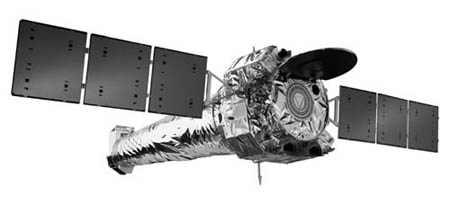The Anatomy of Black Holes - Page 5
• More about Medium-Size Black Holes
In the 1990s, X-ray data from the German-U.S. Roentgen Satellite (ROSAT), and the Japan-U.S. Advanced Satellite for Cosmology and Astrophysics (ASCA) satellite, suggested that a mid-mass black hole might exist in the galaxy M82. This observation was confirmed in September 2000 when astronomers compared the new high resolution Chandra Observatory images with optical, radio, and infrared maps of the region. It is believed that such black holes must be the results of black hole mergers; they are simply too big to have formed from the death of a single star.

|
| Chandra Observatory |
Sometimes called the "missing link" black holes, the medium-sized black holes finally fill in what had stood for decades as a gap in the observed black hole masses between stellar and supermassive. The M82 "missing link" is not in the absolute center of the galaxy where all supermassive black holes reside, but is comparatively close to it. It also seems to be in an area of rapid star formation, and this raises questions about how the mid-size black hole formed.
• More about Supermassive Black Holes
In 1963, Dutch-American astronomer Maarten Schmidt was analyzing observations of a "star" named 3C 273. He had optical and radio data, and it was very confusing. He had discovered what he and his colleagues dubbed a "quasi-stellar radio object" or quasar. The average quasar is no bigger than our solar system, but is brighter than a trillion Suns. We now know that a quasar is a type of Active Galactic Nucleus (AGN) in the heart of an otherwise normal galaxy. We believe that an AGN is nothing more than a typical galaxy with a supermassive black hole in its center, creating an enormous, anomalous luminosity as it accretes nearby material. In addition, through observations, we now understand that quasars were more common at earlier times than the present, and their enormous luminosities make them excellent probes of great distances. They can provide us with fundamental information about the Universe during the time of galaxy formation and early evolution.
We now have objects called quasars, Seyferts, and blazars...all of which we believe may be galaxies with supermassive black holes in their centers. In fact, one currently popular model states that these three types of objects are all the same type of object (a regular galaxy with an active center due to accretion onto a supermassive black hole) viewed from different angles.




